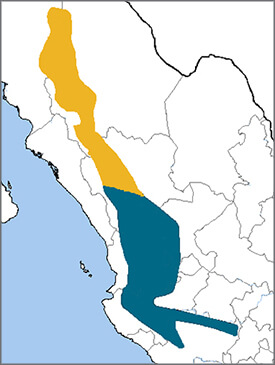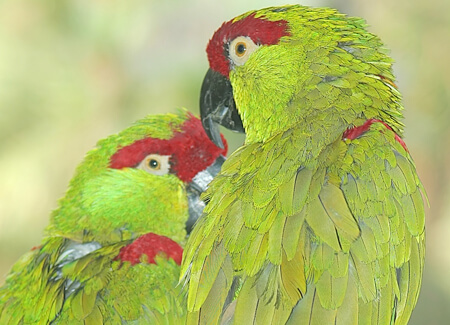 The handsome red-and-green Thick-billed Parrot is the only surviving parrot species native to North America. (The other, the Carolina Parakeet, is long extinct.) This is a parrot of high mountain ranges, or “sky islands,” which it shares with the Violet-crowned Hummingbird, Painted Redstart, and Varied Bunting.
The handsome red-and-green Thick-billed Parrot is the only surviving parrot species native to North America. (The other, the Carolina Parakeet, is long extinct.) This is a parrot of high mountain ranges, or “sky islands,” which it shares with the Violet-crowned Hummingbird, Painted Redstart, and Varied Bunting.
Shooting, logging, and development eliminated the species from its U.S. range, and attempts to reintroduce the species have been unsuccessful. It is included on the 2014 State of the Birds Watch List and was listed as Endangered by the U.S. Fish and Wildlife Service in 1973.
Principal threats to the Thick-billed Parrot are the illegal pet trade, habitat loss (mainly due to logging), and climate change.
Pine Cone Parrot
Thick-billed Parrots are highly social, feeding and roosting in groups. They often fly in a V formation like geese while moving from roosting to feeding areas, and like other parrots, have loud calls that can be heard almost a mile away. This is a species that doesn't mind the cold; the birds are often seen foraging in snow-covered trees and even eating snow as a water source.
Like many parrot species, including the Yellow-eared Parrot and the Golden-plumed Parakeet, the Thick-billed Parrot prefers to nest in tree cavities, especially old woodpecker holes made in large, old aspens or pines.
Sign up for ABC's eNews to learn how you can help protect birds

Thick-billed Parrot by Joshua Haviv, Shutterstock
The birds feed on seeds from various pine species and are dependent on a steady supply of cones, adopting a nomadic lifestyle that follows variations in cone abundance. Thick-billed Parrots even breed in tandem with the peak of pine seed production.
Last Stand in Mexico
Thick-billed Parrots were reintroduced into the mountains of southeastern Arizona in the 1980s, but this effort was unsuccessful, largely due to extensive human development and predation by hawks, particularly Northern Goshawks. The effort was abandoned in 1993, and the last of the introduced parrots was seen in 1995.
For more than 10 years, our partner Pronatura Noreste has been monitoring nests of Thick-billed Parrots in Chihuahua, where ABC funding helped to acquire protected areas for the species. (Read more about this and other bird reserves supported by ABC.)
Confirmed nesting of Thick-billed Parrots in the artificial boxes first occurred in 2008.
Donate to support ABC's conservation mission!



















































